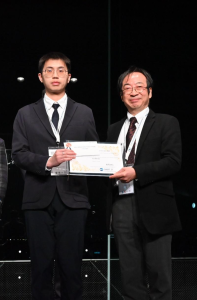2024年04月11日
【Awards and Commendations】Yiji Ye, Kasahara Lab., Department of Nuclear Engineering and Management, D3, received “The 1st Prize in the Heki Shibata Early Career Award” at the 27th International Conference on Structural Mechanics in Reactor Technology (SMiRT27)
On 7/3/2024, Yiji Ye, Kasahara Lab., Department of Nuclear Engineering and Management, D3, received the 1st Prize from 130 candidates in the Heki Shibata Early Career Award at the 27th International Conference on Structural Mechanics in Reactor Technology (SMiRT27).
【Name of the award received】Heki Shibata Early Career Award, 1st Prize
【About awarded research】
Title: Development of failure mitigation technologies for improving resilience of nuclear structures (3) failure mitigation of reactor vessels for excessive earthquakes
Summary: During excessive earthquakes, the Fast Reactor Main Vessel (FRMV) is vulnerable to buckling due to the thin-walled cylindrical structure. Buckling deformation without causing immediate collapse should not be considered as a limit state in Beyond Design Basis Events (BDBEs). Instead, the safety goal is to achieve a stable post-buckling state. In this paper, the post-buckling behavior of pool-type FRMV is experimentally studied, where two kinds of thin-walled cylindrical models are subjected to intense horizontal vibration to cause buckling. Regardless of buckling configuration, the frequency ratio becomes higher than one after buckling, which prevents the post-buckling response from divergence even intense acceleration continues to input. Furthermore, it is confirmed that a higher H/R ratio configuration shows better resilience against catastrophic collapse after buckling than that a low H/R ratio. The findings in this work can contribute to development of passive safety structures for failure mitigation during excessive earthquakes.
【Your impression & future plan 】
I am truly honored to receive this Award. This recognition means a great deal to me and serves as a tremendous source of motivation. I am deeply grateful to my supervisor Professor Kasahara and Professor Ichimiya for their unwavering guidance and support. In my future study, I would continue my work on developing the passive safety strategies of nuclear structures for failure consequence mitigation during BDBEs.



